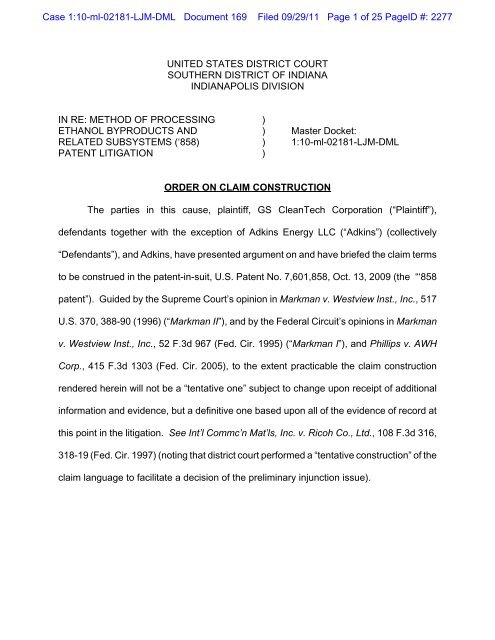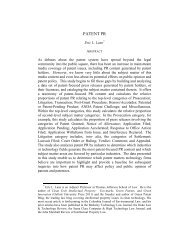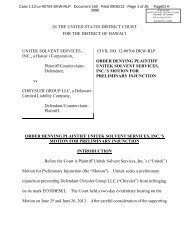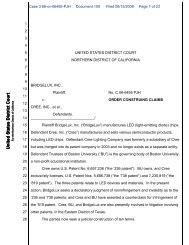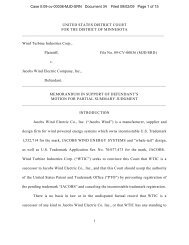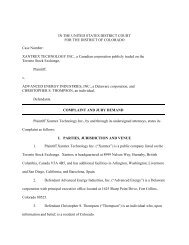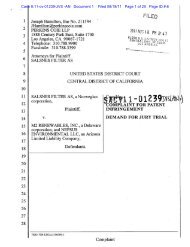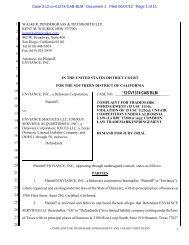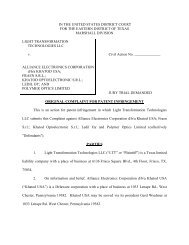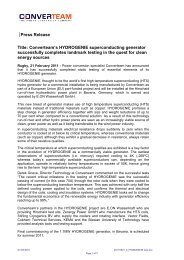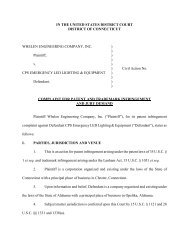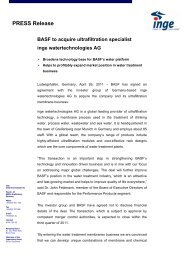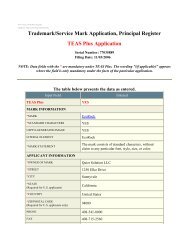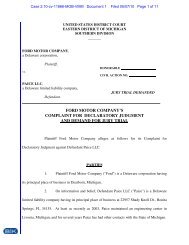GS-Markman-Order - Green Patent Blog
GS-Markman-Order - Green Patent Blog
GS-Markman-Order - Green Patent Blog
Create successful ePaper yourself
Turn your PDF publications into a flip-book with our unique Google optimized e-Paper software.
Case 1:10-ml-02181-LJM-DML Document 169 Filed 09/29/11 Page 1 of 25 PageID #: 2277<br />
UNITED STATES DISTRICT COURT<br />
SOUTHERN DISTRICT OF INDIANA<br />
INDIANAPOLIS DIVISION<br />
IN RE: METHOD OF PROCESSING )<br />
ETHANOL BYPRODUCTS AND ) Master Docket:<br />
RELATED SUBSYSTEMS (‘858) ) 1:10-ml-02181-LJM-DML<br />
PATENT LITIGATION )<br />
ORDER ON CLAIM CONSTRUCTION<br />
The parties in this cause, plaintiff, <strong>GS</strong> CleanTech Corporation (“Plaintiff”),<br />
defendants together with the exception of Adkins Energy LLC (“Adkins”) (collectively<br />
“Defendants”), and Adkins, have presented argument on and have briefed the claim terms<br />
to be construed in the patent-in-suit, U.S. <strong>Patent</strong> No. 7,601,858, Oct. 13, 2009 (the “‘858<br />
patent”). Guided by the Supreme Court’s opinion in <strong>Markman</strong> v. Westview Inst., Inc., 517<br />
U.S. 370, 388-90 (1996) (“<strong>Markman</strong> II”), and by the Federal Circuit’s opinions in <strong>Markman</strong><br />
v. Westview Inst., Inc., 52 F.3d 967 (Fed. Cir. 1995) (“<strong>Markman</strong> I”), and Phillips v. AWH<br />
Corp., 415 F.3d 1303 (Fed. Cir. 2005), to the extent practicable the claim construction<br />
rendered herein will not be a “tentative one” subject to change upon receipt of additional<br />
information and evidence, but a definitive one based upon all of the evidence of record at<br />
this point in the litigation. See Int’l Commc’n Mat’ls, Inc. v. Ricoh Co., Ltd., 108 F.3d 316,<br />
318-19 (Fed. Cir. 1997) (noting that district court performed a “tentative construction” of the<br />
claim language to facilitate a decision of the preliminary injunction issue).
Case 1:10-ml-02181-LJM-DML Document 169 Filed 09/29/11 Page 2 of 25 PageID #: 2278<br />
I. BACKGROUND<br />
A. THE DRY MILLING PROCESS<br />
The specification of the ‘858 patent outlines the ethanol production process, which<br />
is a necessary precursor to the invention claimed in the patent. The Court will discuss this<br />
process before turning its attention to the claimed invention.<br />
Ethanol can be produced using grains such as corn. ‘858 <strong>Patent</strong> col.1 l.28-30.<br />
Using a method called “dry milling,” over two billion gallons of ethanol are produced from<br />
grains, primarily corn, in the United States every year. Id. col.1 l.30-31, 35-36. The dry<br />
milling process utilizes the starch in the corn or other grain to produce ethanol through<br />
fermentation, and it creates a waste stream comprised of byproducts termed “whole<br />
stillage.” Id. col.1 l.40-43. Whole stillage contains, among other things, oil. Id. col.1 l.43.<br />
Whole stillage, after leaving the ethanol fermenting process, may be further separated into<br />
products known as “distillers wet grains” and “thin stillage.” Id. col.1 l.41-43.<br />
B. THE ‘858 PATENT<br />
The ‘858 patent is directed to “a method of processing a concentrated byproduct of<br />
a dry milling process for producing ethanol . . . . In its most basic form, the method<br />
comprises recovering oil from the concentrated byproduct.” Id. col.2 l.18-22. The<br />
specification of the patent repeatedly refers to the invention as a two-step process<br />
comprised of a concentration step and a recovery step. For example, “the method includes<br />
the step of evaporating the thin stillage to form a concentrate. The recovering step may<br />
further comprise separating the oil from the concentrate using a dist stack centrifuge.” Id.<br />
2
Case 1:10-ml-02181-LJM-DML Document 169 Filed 09/29/11 Page 3 of 25 PageID #: 2279<br />
col.2 l.23-27. Although the specific details vary, every embodiment included in the<br />
specification includes an evaporating or concentrating step and an oil recovery step. Id.<br />
col.2 l.50-56; Id. col.2 l.57-61; Id. col.3 l.59-66; Id. col.2 l.24-27; Id. col.2 l.40-49; Id. col.2<br />
l.65-col.3 l.5.<br />
C. THE ASSERTED CLAIMS<br />
Plaintiffs accuse Defendants’ methods of infringing independent claims 1, 8, 10, and<br />
16 and dependent claims 3, 5, 13, and 14 of the ‘858 patent. The asserted claims read:<br />
1. A method of recovering oil from thin stillage, the method<br />
comprising, in sequence: evaporating the thin stillage to remove water and<br />
form a concentrated byproduct; and recovering oil from the concentrated<br />
byproduct by heating and mechanically processing the concentrated<br />
byproduct to separate the oil from the concentrated byproduct, wherein the<br />
concentrated byproduct has a moisture content of greater than 30% and less<br />
than 90% by weight.<br />
***<br />
3. The method of claim 1, wherein the recovering step is performed<br />
on the concentrated byproduct at a temperature of about 180/ F.<br />
***<br />
5. The method of claim 1, wherein the recovering step is performed<br />
on the concentrated byproduct having a pH of between 3 and 6.<br />
***<br />
8. A method of recovering oil from thin stillage, comprising, in<br />
sequence: evaporating the thin stillage to create a concentrate having a<br />
moisture content of greater than 30% by weight and less than about 90% by<br />
weight; and centrifuging the concentrate to recover oil.<br />
***<br />
10. A method of processing whole stillage, comprising: recovering thin<br />
stillage from the whole stillage, the thin stillage including oil and solids;<br />
concentrating the thin stillage including the solids to produce a thin stillage<br />
concentrate, wherein the thin stillage concentrate has a moisture content of<br />
3
Case 1:10-ml-02181-LJM-DML Document 169 Filed 09/29/11 Page 4 of 25 PageID #: 2280<br />
greater than 30% and less than 90% by weight; and recovering oil from the<br />
concentrate by a process consisting essentially of heating and mechanically<br />
processing the concentrate to separate the oil from the concentrate.<br />
***<br />
13. The method of claim 10, wherein the step of recovering the thin<br />
stillage comprises separating the oil from the concentrate using a centrifuge.<br />
***<br />
14. The method of claim 20, wherein the recovering and<br />
concentrating steps are performed in a continuous fashion.<br />
Id. col.5 l.66 to col.6 l.56.<br />
Additional details about the ‘858 patent are included as necessary in the Court’s<br />
discussion of the parties’ arguments.<br />
II. CLAIM CONSTRUCTION STANDARDS<br />
When construing the ‘858 patent’s claims, the Court must determine the meaning<br />
of the language used before it can ascertain the scope of the claims Plaintiff asserts are<br />
infringed. See <strong>Markman</strong> I, 52 F.3d at 979. In doing so, the Court’s interpretive focus is not<br />
the subjective intent of the parties employing a certain term, but the objective test of what<br />
one of ordinary skill in the art at the time of the invention would have understood the term<br />
to mean. See Phillips, 415 F.3d at 1313; Innova/Pure Water v. Safari Water Filtration, 381<br />
F.3d 1111, 1116 (Fed. Cir. 2004). When the Court undertakes its duty to construe the<br />
claims, it first must look to the intrinsic evidence: the asserted and unasserted claims, the<br />
specification, and the prosecution history. See Phillips, 415 F.3d at 1314; Ecolab, Inc. v.<br />
Envirochem, Inc., 264 F.3d 1358, 1366 (Fed. Cir. 2001); Vitronics Corp. v. Conceptronic,<br />
4
Case 1:10-ml-02181-LJM-DML Document 169 Filed 09/29/11 Page 5 of 25 PageID #: 2281<br />
Inc., 90 F.3d 1576, 1581 (Fed. Cir. 1996); <strong>Markman</strong> I, 52 F.3d at 979. Most of the time,<br />
such evidence will provide sufficient information for construing the claims. See Vitronics,<br />
90 F.3d at 1583.<br />
The patent claims should “particularly point out and distinctly clai[m] the subject<br />
matter which the applicant regards as his invention.” <strong>Markman</strong> II, 517 U.S. at 373 (citing<br />
35 U.S.C. § 112). During claim construction, the appropriate starting point for the Court’s<br />
inquiry is always the words of both the asserted and unasserted claims. See Phillips, 415<br />
F.3d at 1314; Elkay Mfg. Co. v. Ebco Mfg. Co., 192 F.3d 973, 977 (Fed. Cir. 1999); see<br />
also Renishaw PLC v. Marposs Societa’ Per Azioni, 158 F.3d 1243, 1248 (Fed. Cir. 1998).<br />
As the Federal Circuit has noted, “[c]ommon words, unless the context suggests otherwise,<br />
should be interpreted according to their ordinary meaning.” Desper Prods., Inc. v. Qsound<br />
Labs., Inc., 157 F.3d 1325, 1336 (Fed. Cir. 1998) (citing York Prods., Inc. v. Central<br />
Tractor Farm & Family Ctr., 99 F.3d 1568, 1572 (Fed. Cir. 1996)); see also Phillips, 415<br />
F.3d at 1314 (citing Brown v. 3M, 265 F.3d 1349, 1352 (Fed. Cir. 2001)). Further, when<br />
there are several common meanings for a term, “the patent disclosure serves to point away<br />
from the improper meanings and toward the proper meaning.” Renishaw, 158 F.3d at<br />
1250. Accord Phillips, 415 F.3d at 1315-17 (discussing the role of the specification in claim<br />
construction).<br />
The correct claim construction is also the one that “stays true to the claim language<br />
and most naturally aligns with the patent’s description of the invention.” Renishaw, 158<br />
F.3d at 1250. See also Phillips, 415 F.3d at 1316. That description, or specification,<br />
serves an important purpose. In it, the patentee must provide a written description of the<br />
invention that would allow a person of ordinary skill in the art to make and use the<br />
5
Case 1:10-ml-02181-LJM-DML Document 169 Filed 09/29/11 Page 6 of 25 PageID #: 2282<br />
invention. See Phillips, 415 F.3d at 1313-14; <strong>Markman</strong> I, 52 F.3d at 979. The applicable<br />
statute requires that “[t]he specification shall contain a written description of the invention,<br />
and of the manner and process of making and using it, in such full, clear, concise, and<br />
exact terms as to enable any person skilled in the art to which it pertains . . . to make and<br />
use the same . . . .” 35 U.S.C. § 112, 1. See also Phillips, 415 F.3d at 1312, 1315;<br />
Johnson Worldwide Assocs.v. Zebco Corp.,, 175 F.3d 985, 993 (Fed. Cir. 1999).<br />
Therefore, to discover the correct meaning of a disputed claim term, the Court must refer<br />
to the specification’s description of the invention.<br />
In addition, a patentee may be his or her own lexicographer and use terms in a<br />
manner different from their ordinary meaning. See Phillips, 415 F.3d at 1316; Johnson<br />
Worldwide Assocs., 175 F.3d at 990; Vitronics, 90 F.3d at 1582. If the patentee chooses<br />
to do that, he or she must clearly state the special definition in the specification or file<br />
history of the patent. See Phillips, 415 F.3d at 1316 (citing CCS Fitness, Inc. v. Brunswick<br />
Corp., 288 F.3d 1359, 1366 (Fed. Cir. 2002)). The specification then serves as a dictionary<br />
when it defines terms, either expressly or by implication, that are used in the claims.<br />
Although claims must be read in light of the specification, limitations from the<br />
specification may not be read into the claims. See Phillips, 415 F.3d at 1323; Comark<br />
Communs. v. Harris Corp., 156 F.3d 1182, 1186 (Fed. Cir. 1998). In particular, the Court<br />
should not limit the invention to the specific examples or preferred embodiment found in the<br />
specification. See Phillips, 415 F.3d at 1323; Tex. Instruments, Inc. v. U.S. Int’l Trade<br />
Comm’n, 805 F.2d 1558, 1563 (Fed. Cir. 1986). Therefore, the “repetition in the written<br />
description of a preferred aspect of a claim invention does not limit the scope of an<br />
invention that is described in the claims in different and broader terms.” Laitram Corp. v.<br />
6
Case 1:10-ml-02181-LJM-DML Document 169 Filed 09/29/11 Page 7 of 25 PageID #: 2283<br />
NEC Corp., 163 F.3d 1342, 1348 (Fed. Cir. 1998). See also Phillips, 415 F.3d at 1323<br />
(describing how to distinguish between a best mode disclosure and a limitation disclosure<br />
in a specification).<br />
Interpreting the meaning of a claim term “‘is not to be confused with adding an<br />
extraneous limitation appearing in the specification, which is improper.’” Laitram, 163 F.3d<br />
at 1348 (quoting Intervet Am., Inc. v. Kee-Vet Lab., Inc., 887 F.2d 1050, 1053 (Fed. Cir.<br />
1989) (further citation omitted by Intervet court)). See also Innova/Pure Water, 381 F.3d<br />
at 1117. An extraneous limitation is a limitation added “wholly apart from any need to<br />
interpret what the patentee meant by particular words and phrases in the claim.” Hoganas<br />
AB v. Dresser Indus., Inc., 9 F.3d 948, 950 (Fed. Cir. 1993). See also Phillips, 415 F.3d<br />
at 1323; Renishaw, 158 F.3d at 1249. Although there is a fine line between reading a claim<br />
in light of the specification and reading a limitation from the specification into the claim, the<br />
Court must look cautiously to the specification for assistance in defining unclear terms. See<br />
Phillips, 415 F.3d at 1323-24; Innova/Pure Water, 381 F.3d at 1117.<br />
The third source of intrinsic evidence is the prosecution history of the patents-in-suit.<br />
See Phillips, 415 F.3d at 1317; Desper Prods., 156 F.3d at 1336-37; Vitronics, 90 F.3d at<br />
1582. In a patent’s prosecution history, the Court will find a complete record of the<br />
proceedings before the PTO leading to issuance of the patent. See Vitronics, 90 F.3d at<br />
1582. The prosecution history contains both express representations made by the<br />
patentee concerning the scope of the patent, as well as interpretations of claim terms that<br />
were disclaimed during the prosecution. See id. at 1582-83; see also Phillips, 415 F.3d at<br />
1317; Ecolab, 264 F.3d at 1368. “The prosecution history can often inform the meaning<br />
of the claim language by demonstrating how the inventor understood the invention and<br />
7
Case 1:10-ml-02181-LJM-DML Document 169 Filed 09/29/11 Page 8 of 25 PageID #: 2284<br />
whether the inventor limited the invention in the course of prosecution, making the claim<br />
scope narrower than it would otherwise be.” Phillips, 415 F.3d at 1317.<br />
In some cases, it may be necessary for the Court to consult extrinsic evidence to aid<br />
it in construing the claim language. See id.; Vitronics, 90 F.3d at 1584. Extrinsic evidence<br />
is any evidence outside of the patent and prosecution history, “including expert and inventor<br />
testimony, dictionaries, and learned treatises.” <strong>Markman</strong> I, 52 F.3d at 980. See also<br />
Phillips, 415 F.3d at 1317. It may be used to assist the Court’s understanding of the patent<br />
or the field of technology. See <strong>Markman</strong> I, 52 F.3d at 980-81. However, “courts [should]<br />
not rely on extrinsic evidence in claim construction to contradict the meaning of claims<br />
discernible from thoughtful examination of the claims, the written description, and the<br />
prosecution history—the intrinsic evidence.” Pitney Bowes, Inc. v. Hewlett-Packard Co.,<br />
182 F.3d 1298, 1308 (Fed. Cir. 1999) (emphasis in original) (citing Vitronics, 90 F.3d at<br />
1583). Judges are not usually “conversant in the particular technical art involved,” or<br />
capable of reading the patent specification and claims as one skilled in the art might. See<br />
<strong>Markman</strong> I, 52 F.3d at 986; see also Pitney Bowes, 182 F.3d at 1308-09. Therefore,<br />
“consultation of extrinsic evidence is particularly appropriate to ensure that [the Court’s]<br />
understanding of the technical aspects of the patent is not entirely at variance with the<br />
understanding of one skilled in the art.” Pitney Bowes, 182 F.3d at 1309. See also Phillips,<br />
415 F.3d at 1318. When the Court relies on extrinsic evidence to assist with claim<br />
construction, and the claim is susceptible to both a broader and a narrower meaning, the<br />
narrower meaning should be chosen if it is the only one clearly supported by the intrinsic<br />
evidence. See Digital Biometrics v. Identix, 149 F.3d 1335, 1344 (Fed. Cir. 1998); see also<br />
Phillips, 415 F.3d at 1317-19 (discussing the proper use of extrinsic evidence). It is entirely<br />
8
Case 1:10-ml-02181-LJM-DML Document 169 Filed 09/29/11 Page 9 of 25 PageID #: 2285<br />
proper for the Court to accept and admit extrinsic evidence, such as an expert’s testimony,<br />
to educate itself but then base its construction solely on the intrinsic evidence. See<br />
Mantech Envt’l Corp. v. Hudson Envt’l Servs., Inc., 152 F.3d 1368, 1373 (Fed. Cir. 1998).<br />
Further, the Federal Circuit has taken special note of the use by courts of a specific<br />
type of extrinsic evidence: dictionaries. In its Vitronics opinion, the court explained that<br />
although technical treatises and dictionaries are extrinsic evidence, judges are free to<br />
consult these resources at any time in order to get a better understanding of the underlying<br />
technologies. 90 F.3d at 1584 n.6. The Vitronics court stated that judges may rely on<br />
dictionaries when construing claim terms as long as the dictionary definition does not<br />
contradict the definition found in, or ascertained by, a reading of the patent. Id. The<br />
Federal Circuit affirmed this approach in Phillips. 415 F.3d at 1322-23.<br />
9
Case 1:10-ml-02181-LJM-DML Document 169 Filed 09/29/11 Page 10 of 25 PageID #: 2286<br />
III. DISCUSSION<br />
A. “concentrated byproduct” [claims 1, 3, 5]/ “concentrate” [claims 8, 10, 13, 14]/<br />
“thin stillage concentrate” [claim 10]/ “concentrated thin stillage” [claim 16]<br />
(collectively, “the Concentrate Terms”)<br />
Claim Term Claim Plaintiff’s<br />
Proposal<br />
“concentrated<br />
byproduct”<br />
“concentrate” 8, 10, 13, 14<br />
“thin stillage<br />
concentrate”<br />
“concentrated<br />
thin stillage”<br />
1,3,5 The product<br />
that remains<br />
after the<br />
removal of<br />
water from thin<br />
stillage,<br />
containing<br />
10<br />
water, oil and<br />
solids<br />
16<br />
10<br />
Defendants’<br />
Proposal<br />
Syrup<br />
containing<br />
water, oil and<br />
solids resulting<br />
from the<br />
concentrating/<br />
evaporating<br />
process<br />
Adkins’<br />
Proposal<br />
Syrup<br />
containing<br />
water, oil, and<br />
solids<br />
produced after<br />
the step of<br />
evaporating<br />
(claims 1-10)<br />
or<br />
concentrating<br />
(claims 10-16)<br />
thin stillage is<br />
complete<br />
The parties agree that the Concentrate Terms can be construed together. The<br />
parties’ proposed constructions indicate that each believes the Concentrate Terms refer<br />
to a substance containing water, oil, and solids. The Defendants and Adkins assert that<br />
the Concentrate Terms should be limited to a syrup resulting from the concentrating or<br />
evaporating process, but Plaintiff argues that Defendants’ and Adkins’ asserted<br />
construction places unnecessary limits on the Concentrate Terms.<br />
Relying on an ordinary dictionary definition, Plaintiff argues that a person of ordinary<br />
skill in the art would understand that to concentrate something means to remove water from<br />
it. Plaintiff argues that by construing the Concentrate Terms as requested by Defendants,<br />
the Court would impermissibly read unstated limitations into the claims. Defendants,
Case 1:10-ml-02181-LJM-DML Document 169 Filed 09/29/11 Page 11 of 25 PageID #: 2287<br />
however, turn their attention to the claim language in order to support their argument that<br />
the Concentrate Terms must be understood as the result of the concentration or<br />
evaporation process. For example, claim 1 discloses “a method comprising, in sequence:<br />
evaporating the thin stillage to remove water and form a concentrated byproduct.” ‘858<br />
patent col.5 l.65-col.6 l.2. Claim 8 also refers to evaporating in order to form the<br />
concentrate. Id. col.6 l.26-30. Claim 10 contemplates “concentrating thin stillage . . . to<br />
produce a thin stillage concentrate.” Id. col.6 l.36-37. Finally, claim 16 discloses a method<br />
for processing corn to “produce ethanol and concentrated thin stillage. Id. col.6 l.59-60.<br />
The Court agrees with Defendants that the claim language itself suggests that the<br />
Concentrate Terms refer to the substance that results from the concentration or<br />
evaporation process. See Phillips, 415 F.3d at 1314. Contrary to Plaintiff’s argument, this<br />
construction does not foreclose the possibility that Plaintiff’s claimed invention can be<br />
practiced continuously. See, e.g., id. col.3 l.2-4. Instead, the process of concentrating or<br />
evaporating can yield the substance referred to by the Concentrate Terms, and then the<br />
substance can be further evaporated or concentrated and continue to yield more of that<br />
substance. However, the language of the claims does indicate that the concentration or<br />
evaporation process precedes the creation of the substance referred to in the Concentrate<br />
Terms. Considering the claim language as described above in light of the specification,<br />
which consistently describes the substance referred to in the Concentrate Terms as what<br />
is formed by the concentration or evaporation step, the Court concludes that construing the<br />
Concentrate Terms as a substance “resulting from the concentrating/evaporating process”<br />
is supported by the intrinsic evidence.<br />
11
Case 1:10-ml-02181-LJM-DML Document 169 Filed 09/29/11 Page 12 of 25 PageID #: 2288<br />
To that end, the Court rejects Adkins’ proposed language because it reads an<br />
impermissible unstated limitation into the claims. See Northern Telecom Ltd. v. Samsung<br />
Elecs., Co., Ltd., 215 F.3d 1291, 1290 (Fed. Cir. 2000) (noting that the Federal Circuit has<br />
“repeatedly and clearly held that it will not read unstated limitations into claim language”).<br />
Specifically, it reads the possibility of a continuous process out of the scope of Plaintiff’s<br />
claims by indicating that the water removal step must be absolutely complete before any<br />
of the substance referred to by the Concentrate Terms moves on to the next step.<br />
The question remaining in the construction of the Concentrate Terms is how the<br />
substance to which they refer should be understood. Plaintiff offers that its is a “product”<br />
consisting of water, oil and solids, but Defendants and Adkins argue that a person of<br />
ordinary skill in the art would understand the term to mean “syrup” consisting of oil, water,<br />
and solids. Plaintiff asserts conclusorily that its word, “product,” can but does not have to<br />
mean “syrup” and nothing in the claim language limits the substance to which the<br />
Concentrate Terms refer to “syrup.” However, Defendants present evidence that a person<br />
of ordinary skill in the art at the time of the invention would understand the composition<br />
resulting from the evaporation process in an ethanol plant to be “syrup.” See U.S. <strong>Patent</strong><br />
No. 5,662,810 (Sept. 2, 1997), col.1 l.57-62. Additionally, Defendants point out that the<br />
specification uses the terms “concentrate” and “syrup” interchangeably to describe the<br />
composition described by the Concentrate Terms. See ‘858 patent col.1 l.48; id. col.3 l.53<br />
(using the phrase “concentrate or syrup” to refer to the substance resulting from the<br />
evaporation of thin stillage); id. col.4 l.8 (same); id. col.4 l.43-44 (same). Although the<br />
Court may not read limitations into the claim terms from the specification, the ‘858 patent’s<br />
claims do not describe the invention in broader or different terms than those included in the<br />
12
Case 1:10-ml-02181-LJM-DML Document 169 Filed 09/29/11 Page 13 of 25 PageID #: 2289<br />
specification. Instead, in this instance, “syrup” most naturally aligns the claim language<br />
with the language of the specification. See Renishaw, 158 F.3d at 1250. Accordingly, the<br />
Court interprets the Concentrate Terms as meaning “syrup containing water, oil, and solids<br />
resulting from the concentrating or evaporating process.”<br />
B. “mechanically processing” [claims 1, 10, 16]<br />
Claim Phrase Claim Plaintiff’s<br />
Proposal<br />
mechanically<br />
processing<br />
1, 10, 16 To subject to a<br />
mechanical<br />
device (or<br />
devices) to<br />
effect a<br />
particular<br />
result.<br />
13<br />
Defendants’<br />
Proposal<br />
Processing<br />
with a<br />
centrifuge<br />
Adkins’<br />
Proposal<br />
Separating<br />
components of<br />
a mixture with<br />
a centrifuge<br />
Defendants and Adkins argue the ‘858 patent’s specification and prosecution history<br />
both prove that “mechanically processing” means “processing with a centrifuge.” Plaintiff,<br />
conversely, argues that neither the specification nor the prosecution history specifically<br />
disclaim other mechanical processing methods aside from centrifuging. Further, Plaintiff<br />
argues that the doctrine of claim differentiation requires that the phrase “mechanically<br />
processing” mean something more broad and distinct from processing with a centrifuge.<br />
The claims at issue do not include any language describing the phrase<br />
“mechanically processing” as involving only a centrifuge. In fact, claim 8 discloses a<br />
“method of recovering oil from thin stillage, comprising, in sequence: evaporating the thin<br />
stillage . . . and centrifuging the concentrate to recover oil.” ‘858 patent, col.6 l.26-30.<br />
Conversely, claim 1, like claims 10 and 16, discloses a method where the recovery step is
Case 1:10-ml-02181-LJM-DML Document 169 Filed 09/29/11 Page 14 of 25 PageID #: 2290<br />
accomplished by “heating and mechanically processing the concentrated by-product.” Id.<br />
col.5-6 l.65-7. In these claims, no mention is made of centrifuguing. When different words<br />
or phrases are used in separate claims, a difference in meaning is presumed. Tandon<br />
Corp. v. U.S. Int’l Trade Comm’n, 831 F.2d 1017, 1023 (Fed. Cir. 1987). This principle of<br />
claim differentiation would suggest that the difference in the use of terms is significant and<br />
that “mechanically processing” should not be limited to processing with a centrifuge.<br />
Defendants and Adkins, however, argue that the Court should not stop its inquiry<br />
with the doctrine of claim differentiation. Citing Nystrom v. Trex Co., Defendants and<br />
Adkins argue that the consistent description of mechanical processing as centrifuging in<br />
the subject patent frames the invention as using only a centrifuge. 424 F.3d 1136 (Fed.<br />
Cir. 2005). Indeed, “[d]ifferent terms or phrases in separate claims may be construed to<br />
cover the same subject matter where the written description and prosecution history<br />
indicate that such a reading of the terms or phrases is proper.” Id. at 1143. Defendants<br />
specifically point to the ‘858 patent where it states that the “the preferred embodiment<br />
essentially requires the addition of a centrifuge.” ‘858 patent, col.5 l.34-36. Defendants go<br />
on to argue that at column 5, lines 42-63, the ‘858 patent specifies types of centrifuges that<br />
would work in the preferred embodiment. Unlike the patent in Nystrom, the context<br />
provided in the ‘858 patent’s specification does not make clear that the inventor<br />
contemplated only centrifuging as a method of “mechanical processing.” See 424 F.3d at<br />
1143. Claims are not limited to the preferred embodiment in the specification. Glaxo<br />
Wellcome, Inc. v. Andrx Pharms., Inc., 344 F.3d 1226, 1233 (Fed. Cir. 2003). The<br />
specification of the ‘858 patent states specifically that “[m]odifications or variations” on the<br />
preferred embodiment are possible and, further, that in addition to various types of<br />
14
Case 1:10-ml-02181-LJM-DML Document 169 Filed 09/29/11 Page 15 of 25 PageID #: 2291<br />
centrifuges, “other like devices for separating oil from a substance including suspended<br />
solids” would be suitable for recovering oil in the recovery step. Accordingly, the Court<br />
concludes that the context for the claims provided by the specification does not indicate that<br />
the claims refer only to centrifuging. The language of the claims themselves indicates that<br />
there is a difference between mechanically processing and processing with a centrifuge.<br />
Plaintiff contends that the Court should give the phrase “mechanically processing”<br />
its ordinary meaning. There is no evidence to indicate that one with ordinary skill in the art<br />
at the time of the invention would understand “mechanically processing” to mean anything<br />
other than Plaintiff’s proffered definition. “Mechanically processing” does not require<br />
elaborate definition, as its meaning is relatively apparent. See Brown v. 3M, 265 F.3d<br />
1349, 1352 (Fed. Cir. 2001). Therefore, the Court agrees with Plaintiff that “mechanically<br />
processing” means “to subject to a mechanical device (or devices) to effect a particular<br />
result.”<br />
15
Case 1:10-ml-02181-LJM-DML Document 169 Filed 09/29/11 Page 16 of 25 PageID #: 2292<br />
C. “[heating and] mechanically processing the concentrated byproduct to<br />
separate the oil from the concentrated byproduct” [claim 1]/ “[heating and]<br />
mechanically processing the concentrate to separate the oil from the<br />
concentrate” [claim10]/ “[heating and] mechanically processing the concentrated<br />
thin stillage to separate the oil from the concentrate” [claim 16]<br />
Claim Phrase Claim Plaintiff’s<br />
Proposal<br />
[heating and]<br />
mechanically<br />
processing the<br />
Concentrate<br />
Term separate<br />
the oil from the<br />
Concentrate<br />
Term<br />
heating . . . the<br />
Concentrate<br />
Term<br />
1, 10,<br />
16<br />
1, 10,<br />
16<br />
The Concentrate<br />
Term (as Plaintiff<br />
proposes it be<br />
construed) is<br />
subjected to heat<br />
and a mechanical<br />
device (or<br />
devices) to extract<br />
a product that is<br />
substantially oil<br />
from the<br />
Concentrate Term<br />
16<br />
Defendants’<br />
Proposal<br />
processing with a<br />
centrifuge the<br />
syrup containing<br />
water, oil and<br />
solids to separate<br />
the oil from the<br />
syrup so that the<br />
oil stream coming<br />
out of the<br />
centrifuge is oil<br />
without water<br />
and/or solids and<br />
the syrup stream<br />
coming out of the<br />
centrifuge is<br />
substantially free<br />
of oil<br />
Same as above heating the<br />
Concentrate<br />
Term after the<br />
Concentrate<br />
Term has left the<br />
concentrating or<br />
evaporating<br />
process<br />
Adkins’<br />
Proposal
Case 1:10-ml-02181-LJM-DML Document 169 Filed 09/29/11 Page 17 of 25 PageID #: 2293<br />
Heating 1, 10,<br />
16<br />
Subjecting to a<br />
source of heat<br />
17<br />
Adding an<br />
external source<br />
of heat energy to<br />
raise the<br />
temperature of<br />
the concentrate,<br />
or concentrated<br />
thin stillage after<br />
the evaporating<br />
or concentrating<br />
step is complete<br />
The parties disagree as to whether these phrases should be construed in their<br />
entirety. Plaintiff contends that the Court should construct the phrases including the<br />
bracketed “heating” language. Defendants, conversely, argue that the Court should<br />
construe the phrase in two pieces. Specifically, Defendants request construction of the<br />
phrase “mechanically processing the concentrate to separate the oil from the concentrate”<br />
and similar phrases from claims 1 and 16, and then request a separate construction of the<br />
phrase “heating . . . the concentrate to separate the oil from the concentrate” and similar<br />
phrases from claims 1 and 16.<br />
Defendants argue that the phrase should be constructed in parts in order to make<br />
clear that claims require the heat to be applied after the concentrated byproduct leaves the<br />
evaporating process. Plaintiff argues that the phrase Defendants ask to have constructed<br />
has no meaning without the bracketed “heating and” language because the separation of<br />
the oil is accomplished by both heating and mechanically processing the concentrated<br />
byproduct. The Court agrees with Plaintiff that the phrases should be constructed in their<br />
entirety. See On Demand Mach. Corp. v. Ingram Indus., Inc., 442 F.3d 1331, 1344 (Fed.<br />
Cir. 2006) (“Care must be taken lest word-by-word definition, removed from the context of
Case 1:10-ml-02181-LJM-DML Document 169 Filed 09/29/11 Page 18 of 25 PageID #: 2294<br />
the invention, leads to an overall result that departs significantly from the patented<br />
invention.”). The Court, however, emphasizes that the Concentrate Terms, as they appear<br />
in these phrases should be construed as described above. The Court’s construction of the<br />
Concentrate Terms confirms that the syrup referred to by those terms results from the<br />
evaporation or concentration process. In the context of the complete phrase, it should be<br />
apparent that the heat and mechanical processing that the syrup is subjected to occurs<br />
post-evaporation. Indeed, the prosecution history indicates that the heating and<br />
mechanical processing of the concentrate occurs separately from and after the evaporation<br />
step. Plaintiff stated, in order to overcome the patent office’s rejection premised on<br />
obviousness, that it “carefully studied Prevost [a published patent application] and can find<br />
no teaching or suggestion of a post evaporation process for recovering oil from the<br />
concentrated byproduct by heating and mechanical processing as in claim 1 and 16 or by<br />
centrifuging as in claim 14.” Dkt. No. 120-5 at 104 (emphasis in original). Therefore, to<br />
distinguish itself from Prevost, Plaintiff clearly disclaimed that the heating that occurs as<br />
part of the oil recovery step occurred at any time prior to or as a part of the evaporation or<br />
concentrating step. The Court concludes that its construction of the Concentrate Terms<br />
is sufficient to make clear that in order to practice the ‘858 patent, the heating and<br />
mechanically processing of the syrup referred to by the Concentrate Terms must occur<br />
post-evaporation.<br />
Plaintiff argues that grammar, logic, and the specification do not require completion<br />
of the evaporation step prior to the oil recovery step. To the extent that Plaintiff argues that<br />
as to a single batch of the syrup referred to by the Concentrate Terms, the steps can<br />
overlap, the Court disagrees. The prosecution history, as detailed above, makes clear that<br />
18
Case 1:10-ml-02181-LJM-DML Document 169 Filed 09/29/11 Page 19 of 25 PageID #: 2295<br />
the claims refer to a post evaporation/concentration oil recovery step consisting of<br />
mechanical processing and heat application. This, however, does not render claim 14,<br />
which states that the method claimed in the patent can be practiced continuously, null. The<br />
patent can still be practiced in a continuous fashion, but the heat applied in the oil recovery<br />
step must be separate from any heat applied in order to evaporate or concentrate any<br />
particular batch of thin stillage. Indeed, the patent could, for example, be practiced by<br />
applying heat to evaporate the thin stillage in order to produce the concentrated byproduct.<br />
Then the recovery step could be accomplished by applying additional heat and centrifuging<br />
the concentrated byproduct in order to recover the oil. That step may encompass both<br />
evaporation for a new batch of thin stillage that remains after the oil is recovered from the<br />
initial batch, and the recovery step for the thin stillage that was already concentrated. Then<br />
another centrifuge may be used to process the newly concentrated thin stillage remaining<br />
after the oil is recovered from the initial thin stillage. In order to practice the patent,<br />
however, further heat must be applied while mechanically processing the new batch of thin<br />
stillage. The key to harmonizing the claim language in which the patent teaches that its<br />
method can be practiced continuously and the prosecution history that clarifies that the oil<br />
recovery must be a post-evaporation process is subjecting the concentrate to a heat source<br />
every time it undergoes the oil recovery step.<br />
Before the Court considers the claim phrase in its entirety, it must address Adkins’<br />
request for a construction of the term “heating.” Adkins proposes that the term “heating”<br />
be construed to mean “adding an external source of heat energy to raise the temperature<br />
of the concentrate (concentrated byproduct or concentrated thin stillage) after the<br />
evaporating or concentrating step is complete. Adkins’ argument focuses on the latter part<br />
19
Case 1:10-ml-02181-LJM-DML Document 169 Filed 09/29/11 Page 20 of 25 PageID #: 2296<br />
of its proposed meaning, emphasizing that the prosecution history makes clear that the<br />
term “heating,” as it is used in the claims, refers to the step that occurs after the<br />
evaporation or concentration step is complete. As the Court has explained above, its<br />
construction of the Concentrate Terms clarifies that the heating referred to in the above<br />
enumerated claims must occur separately from the evaporation or concentration step.<br />
Adkins further argues that Plaitniff’s proposed construction is insufficient because<br />
it defines “heating” in reference to the word “heat.” Relying on the CRC Handbook of<br />
Chemistry and Physics, Adkins asserts that a person of ordinary skill in the art would<br />
understand that when processing ethanol byproducts “heating” means raising the<br />
temperature of the material being heated. Plaintiff argues that Adkins is adding limitations<br />
to the term that are not required by the ‘858 patent. The Court agrees that Adkins’<br />
proposed construction does include limitations not required by the language of the ‘858<br />
patent. The Court concludes that the term “heating” has a well understood ordinary<br />
meaning and that construing it any other way is unnecessary. See Phillips, 415 F.3d at<br />
1314.<br />
The Court will now turn its attention to the language of the phrase “heating and<br />
mechanically processing the concentrate/concentrated byproduct/concentrated thin stillage<br />
to separate the oil from the concentrate/concentrated byproduct/concentrated thin stillage”<br />
as it appears in claims 1, 10, and 16. As the Court discussed, the Concentrate Terms<br />
appearing in each of these phrases should be construed as the Court construes them<br />
above. Plaintiffs do not argue against Defendants’ assertion that the syrup stream leaving<br />
the oil recovery step is substantially free of oil. The primary disagreement between the<br />
parties centers on the whether the oil stream resulting from the heating and mechanical<br />
20
Case 1:10-ml-02181-LJM-DML Document 169 Filed 09/29/11 Page 21 of 25 PageID #: 2297<br />
processing is “substantially oil” or “oil free from water and/or solids.” Defendants point to<br />
the specification and the prosecution history to show that the phrase must mean that the<br />
oil is separated from the syrup such that the oil recovered from the inventive process is oil<br />
without water and solids.<br />
With respect to the specification Defendants specifically argue that Plaintiff’s use of<br />
the term “usable oil” in the specification together with Figure 2 in the ‘858 patent, which<br />
specifies that the oil recovered does not contain any water or solids, indicate that the claim<br />
terms must refer to the recovery of oil free from solids and water. Citing two separate<br />
portions of the specification, Defendants also assert that the specification limits the claims<br />
to “usable oil.” Plaintiff counters Defendants’ assertions by pointing out that there are only<br />
three references to “usable oil” or “oil in a usable form” in the specification, but there are<br />
several references to “oil” in the specification without any reference to “usable oil.” Further,<br />
Plaintiff points out that the two citations to the specification that Defendants contend<br />
support claim limitations to “usable oil” are inapposite. Indeed, the first citation, “Col. 3:65"<br />
includes the end of a sentence regarding pH levels and the beginning of a sentence<br />
regarding evaporation. The other citation, “Col. 5:27-36,” discusses a preferred<br />
embodiment that includes a centrifuge to recover “oil,” not “usable oil.” Accordingly, the<br />
Court concludes that the two citations provided by Defendants do not support the notion<br />
that the specification limits the claims to oil free from water and solids. Further, a few<br />
references to “usable oil” amid several references to “oil” in the specification does not<br />
amount to a limitation on the claims either. Finally, Figure 2 does not limit the claims to its<br />
terms explicitly. The cases are clear that the Court may not limit claims to preferred<br />
embodiments. See, e.g., Kara Tech. Inc. v. Stamps.com Inc., 582 F.3d 1341, 1348 (Fed<br />
21
Case 1:10-ml-02181-LJM-DML Document 169 Filed 09/29/11 Page 22 of 25 PageID #: 2298<br />
Cir. 2009) (“The patentee is entitled to the full scope of his claims, and we will not limit him<br />
to his preferred embodiment or import a limitation from the specification into the claims.”).<br />
Therefore, the Court concludes that nothing in the specification limits the claims as argued<br />
by Defendants.<br />
The other argument Defendants present is that the prosecution history supports their<br />
proposed construction. Prevost was one of the main pieces of prior art cited against the<br />
‘858 patent during prosecution. Dkt. No. 120-5 at 81-82, 114-115. Twice the patentee<br />
distinguished the claims of the ‘858 patent from Prevost on the basis that it had “carefully<br />
studied Prevost and [could] find no teaching or suggestion of a post evaporation process<br />
for recovering oil from the concentrated byproduct.” Id. at 104, 128 (emphasis in original).<br />
Defendants argue that Prevost does, in fact, disclose a post evaporation process for<br />
recovering oil from the concentrated byproduct that consists of mechanical processing.<br />
Accordingly, argue Defendants, Prevost renders the ‘858 patent claims obvious if the post<br />
evaporation process is the only difference between Prevost and the ‘858 patent. Citing the<br />
rule that claims should be constructed with an eye toward validity, Defendants state that<br />
the quality of the oil that results from the post-evaporation processing must distinguish the<br />
‘858 patent from Prevost. See Becton, Dickinson & Co v. Tyco Heathcare Grp., LP, 616<br />
F.3d 1249, 1255 (Fed. Cir. 2010).<br />
The Court disagrees with Defendants’ characterization of the ‘858 patent’s<br />
prosecution history. The Court could not find any statements in the prosecution history to<br />
indicate that Applicants limited their methods to the recovery of oil alone, free from water<br />
and solids. Indeed, Applicants do distinguish their claimed methods from Prevost, but they<br />
do so explicitly on the grounds that their claimed method teaches a post-evaporation<br />
22
Case 1:10-ml-02181-LJM-DML Document 169 Filed 09/29/11 Page 23 of 25 PageID #: 2299<br />
process for recovering oil from the concentrate using heat and mechanical processing.<br />
Defendants also cite Applicants’ statements regarding evaporation freeing some of the<br />
bound oil and how Minowa in combination with Prevost fail to teach or suggest “recovering<br />
the oil from the concentrated byproduct by heating and mechanically processing the<br />
concentrated byproduct to separate the oil from the concentrated byproduct.” Neither of<br />
these statements reference the recovery of oil free from water and solids. Indeed,<br />
Defendants state that they “presume” that is what Applicants were referencing. However<br />
nothing in the context of the prosecution history indicates that Defendants’ presumption is<br />
correct. Defendants’ assumptions regarding the grounds on which Applicants distinguished<br />
from Prevost are completely without support in the record of the prosecution history.<br />
Although the Court acknowledges that patent claims are generally construed so as to<br />
sustain their validity, the Court will not abandon the well established principles of claim<br />
construction in order to address a validity issue that is not currently before it. See<br />
Whittaker Corp. v. UNR Indus., Inc., 911 F.2d 709, 712 (Fed. Cir. 1990). Accordingly, the<br />
Court concludes that Applicants did not limit the scope of the claims in either the<br />
specification or the prosecution history. Therefore, the Court construes the language in<br />
claims 1, 10 and 16 as: “the Concentrate Term (as construed by the Court in this <strong>Order</strong>)<br />
subjected to heat and a mechanical device (or devices) to extract a product that is<br />
substantially oil from the Concentrate Term (as construed by the Court in this <strong>Order</strong>).”<br />
23
Case 1:10-ml-02181-LJM-DML Document 169 Filed 09/29/11 Page 24 of 25 PageID #: 2300<br />
D. “centrifuging the concentrate to recover oil” [claim 8]<br />
Claim Phrase Claim Plaintiff’s Proposed<br />
Construction<br />
“centrifuging<br />
the<br />
concentrate to<br />
recover oil”<br />
8 Processing the<br />
concentrate (as<br />
defined in Plaintiff’s<br />
proposed construction<br />
for the Concentrate<br />
Terms) with a<br />
centrifuge to separate<br />
the oil from the<br />
concentrate so that the<br />
oil stream coming out<br />
of the centrifuge is<br />
substantially oil and<br />
the remaining<br />
concentrate stream<br />
coming out of the<br />
centrifuge is<br />
substantially free from<br />
oil<br />
24<br />
Defendants’<br />
Proposed<br />
Construction<br />
processing with<br />
a centrifuge the<br />
syrup containing<br />
water, oil and<br />
solids to<br />
separate the oil<br />
from the syrup<br />
so that the oils<br />
tream coming<br />
out of the<br />
centrifuge is oil<br />
without water<br />
and/or solids and<br />
the syrup stream<br />
coming out of the<br />
centrifuge is<br />
substantially free<br />
of oil.<br />
Adkins’<br />
Proposed<br />
Construction<br />
The parties present no new arguments as to the construction of this phrase in claim<br />
8. For the reasons discussed above, the Court adopts Plaintiff’s proposed construction with<br />
the modification that “concentrate” should be defined as the Court construes it in this <strong>Order</strong>.<br />
Accordingly, the Court concludes that “centrifuging the concentrate to recover oil” means:<br />
“processing the concentrate (as defined by the Court in this <strong>Order</strong>) with a centrifuge to<br />
separate the oil from the concentrate so that the oil stream coming out of the centrifuge is<br />
substantially oil and the remaining concentrate stream coming out of the centrifuge is<br />
substantially free of oil.”
Case 1:10-ml-02181-LJM-DML Document 169 Filed 09/29/11 Page 25 of 25 PageID #: 2301<br />
IV. CONCLUSION<br />
For the foregoing reasons, the Court construes the disputed terms of the patent-in-<br />
suit, U.S. <strong>Patent</strong> No. 7,601,858, Oct. 13, 2009 as follows:<br />
Claim Term Construction<br />
“concentrate”/”concentrated<br />
byproduct”/”concentrated thin stillage”<br />
25<br />
“syrup containing water, oil, and solids<br />
resulting from the concentrating or<br />
evaporating process”<br />
“mechanically processing” “to subject to a mechanical device (or<br />
devices) to effect a particular result”<br />
“heating and mechanically processing the<br />
concentrate/concentrated<br />
byproduct/concentrated thin stillage to<br />
separate the oil from the<br />
concentrate/concentrated<br />
byproduct/concentrated thin stillage”<br />
“centrifuging the concentrate to recover<br />
oil”<br />
IT IS SO ORDERED this 29 th day of September, 2011.<br />
Distribution to all counsel of record.<br />
“the Concentrate Term (as construed by<br />
the Court in this <strong>Order</strong>) subjected to heat<br />
and a mechanical device (or devices) to<br />
extract a product that is substantially oil<br />
from the Concentrate Term (as construed<br />
by the Court in this <strong>Order</strong>)”<br />
“processing the concentrate (as defined<br />
by the Court in this <strong>Order</strong>) with a<br />
centrifuge to separate the oil from the<br />
concentrate so that the oil stream coming<br />
out of the centrifuge is substantially oil<br />
and the remaining concentrate stream<br />
coming out fo the centrifuge is<br />
substantially free of oil”<br />
________________________________<br />
LARRY J. McKINNEY, JUDGE<br />
United States District Court<br />
Southern District of Indiana


